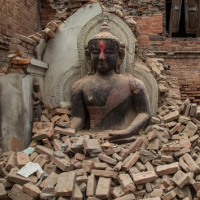Less Than Half of India’s Quake Sensors are Working
 A collapsed temple in Bhaktapur, Nepal (photo: Getty Images)
A collapsed temple in Bhaktapur, Nepal (photo: Getty Images)
The ministry of earth sciences admitted on Tuesday that only 40 of the 100 ground motion detectors it checked so far are in working condition. This follows media reports that the country’s network of 293 sensors failed to record the April 25 earthquake in neighbouring Nepal because of a bureaucratic delay.
The ministry says that 40 detectors are working but it has uploaded data only from seven detectors on to its website for geologists to access.
“Those that are not in working condition have to be upgraded,” a ministry official told the Hindustan Times.
The detectors – known as accelerographs – were installed between 2005 and 2008 by the Indian Institute of Technology, Roorkee, across 14 northern states, and form the basis of India’s earthquake early warning system.
The imported devices measure movement generated during an earthquake. These cost Rs 20 crore ($3.1 million) each, with maintenance alone costing around Rs 1 crore ($156,000) every year. But funding was cut last September after the government decided to move the network out of IIT-Roorkee’s control to the National Centre for Seismology (NCS), an institution under the ministry.
"During this government takeover, someone perhaps forgot that the sensors need maintenance," Ram Iyengar, an earthquake engineering specialist, told The Telegraph.
One month before the earthquakes, Prof. Ashok Kumar at IIT Roorkee wrote to the ministry, cautioning that the network has not been maintained for the past six months and several instruments may not be operational.
"Our country will cut a very sorry face if a big earthquake event occurs as in the present stage of the instrumentation, we may not get any strong motion record(s)," he wrote in an email to the ministry on March 26 – almost exactly a month before the first earthquake.
Despite this warning, the ministry still did not check whether the network was operational. Now, with two big earthquakes in the past 2 weeks, the ministry is trying to get the system back on track.
Brijesh Bansal, a senior scientist at the ministry told The Telegraph that a team has been sent to find out the status of the detectors and to “take charge of the instruments.”
The ground motion readings that these sensors record are crucial to understand just how an earthquake might affect the buildings and other structures in our cities. This will help plan engineering strategies to reduce the risk of damage from an earthquake.
- Karan Singh
To Learn More:
Indian sensors slept through quake (by G.S Mudur, The Telegraph)
India’s quake detectors in a coma for 8 months due to bureaucratic bottleneck (by Zia Haq, Hindustan Times)
Nepal earthquake: How defunct seismological instruments could make India pay (by Nistula Hebbar, Economic Times)
- Top Stories
- Controversies
- Where is the Money Going?
- India and the World
- Appointments and Resignations
- Unusual News
- Latest News
- India College Chain’s Expansion into U.S. Draws Opposition from Massachusetts Officials over Quality of Education
- Milk Shortages in India Tied to Release of New Movies Featuring Nation’s Favorite Stars
- Confusion Swirls around Kashmir Newspaper Ban in Wake of Violent Street Protests
- Polio-Free for 5 Years, India Launches Vaccine Drive after Polio Strain Discovery
- New Aviation Policy Could Increase Service, Lower Ticket Prices






Comments